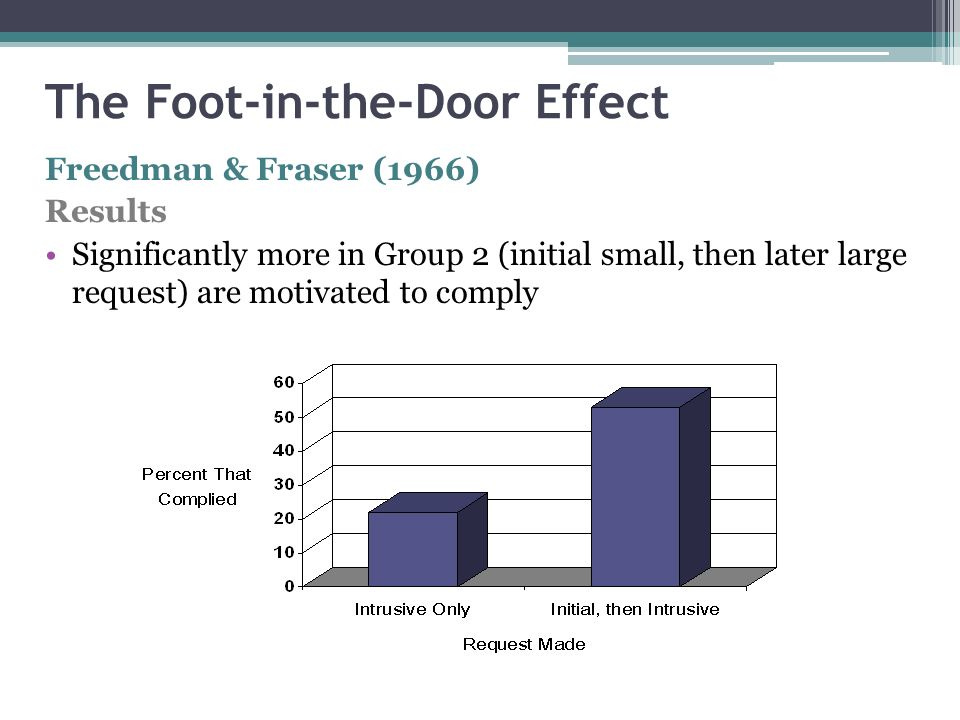Foot in the Door - Psychological Manipulation
How to be Aware of Dangerous Psychological Manipulation
It's important to pay attention to seemingly random actions, like Trump renaming the Gulf of Mexico to the Gulf of America. This strategy is a form of psychological conditioning aimed at getting people to accept his will in small doses. Psychology explains that individuals are more likely to agree to larger requests if they've already agreed to smaller ones, a concept known as the "foot-in-the-door" technique. By securing agreement on minor matters, it's easier to obtain consent on more significant issues. This method conditions people to not push back and to accept incremental changes. It's a dangerous tactic that should alarm us all, as it aims to erode resistance and foster compliance. We must hold the line and resist such tyranny.
The "foot-in-the-door" phenomenon is a psychological concept where people are more likely to agree to a larger request after first agreeing to a smaller one. This technique leverages cognitive dissonance, where once someone commits to an initial action, they are more inclined to align future actions with that commitment to maintain consistency in their behavior and self-perception.
First studied in the 1960s by psychologists Jonathan Freedman and Scott Fraser, the phenomenon was demonstrated through an experiment. Participants who initially agreed to a small request, like answering a brief survey, were significantly more likely to comply with a much larger request later, such as allowing researchers into their homes for a lengthy interview. This showed how modest commitments can pave the way for more substantial agreements.
The "foot-in-the-door" technique is strongly associated with taking advantage of individuals. It relies on the principle of commitment and consistency, where people feel compelled to align their actions with previous agreements, even if those actions become increasingly harmful or unethical. This makes individuals vulnerable to exploitation, as they may find themselves agreeing to larger and more significant requests without fully realizing the implications.
This technique is widely used in fields such as marketing, sales, and social influence. For example, a salesperson might start by asking you to try a free sample before encouraging you to make a purchase. Similarly, charities often request small donations initially, knowing that individuals who donate once are more likely to donate again in the future.
In politics, subtle strategies can be employed to manipulate public opinion and introduce controversial policies gradually. For instance, politicians might begin with a small, uncontroversial policy change that is easy for the public to accept, such as a minor tax adjustment. Once the initial change is accepted, they can incrementally introduce more significant and potentially controversial reforms that would have faced resistance if proposed outright. Similarly, a political campaign might start with a widely accepted initiative, like anti-bullying programs in schools, to gain public support. With this support in place, they can then push for broader social reforms that are more divisive.
This technique highlights the subtle ways in which public opinion can be shaped and how incremental persuasion can be used to achieve bigger and more substantial goals. While the "foot-in-the-door" phenomenon can be a powerful tool for positive change, its potential for misuse in politics demonstrates the importance of being aware of how our behaviors and beliefs can be influenced incrementally. Studies on the "foot-in-the-door" phenomenon primarily highlight its effectiveness in gaining compliance. However, there are more sinister aspects that could be considered alarming. The technique's success lies in its subtlety, which can make it easy to manipulate individuals without their awareness. This raises ethical concerns, particularly when the technique is used to exploit people's tendency to maintain consistency in their actions and beliefs.
For instance, in political or marketing contexts, the incremental nature of the technique can lead to the gradual acceptance of more significant and potentially harmful requests or policies. This potential for manipulation underscores the importance of being aware of how our behaviors and beliefs can be influenced, sometimes without us even realizing it. While the "foot-in-the-door" phenomenon is a powerful tool for persuasion, its ability to subtly shape behavior and opinions highlights the need for serious ethical considerations in its application. It's also a powerful reminder of the fine line between effective persuasion and deceptive manipulation.
The "foot-in-the-door" phenomenon has been clearly substantiated by multiple scientific studies, the most notable being the 1966 research conducted by Jonathan Freedman and Scott Fraser. Their experiments revealed that individuals who complied with a small request, such as signing a petition, were more likely to agree to a subsequent, larger request, like allowing a researcher into their home. Further support came from a 1990 study by James Price Dillard, which examined the self-perception theory and found that initial compliance influenced later behavior. Furthermore, a meta-analysis by Alan Beaman and colleagues in 1983 reviewed 15 years of related research, consistently affirming the technique's effectiveness across various contexts. These studies collectively provide robust empirical evidence for the "foot-in-the-door" phenomenon.
The gradual and incremental steps used in the "foot-in-the-door" phenomenon can closely relate to cult mentalities, where subtle persuasion techniques are employed to gain initial commitment from potential members. Cults often start by asking individuals to attend a simple, low-commitment event or meeting. Once someone agrees and attends, they are more likely to comply with subsequent, more demanding requests, such as participating in group activities, making financial contributions, or adopting the cult's beliefs and practices. This incremental approach creates a sense of commitment and consistency, making it harder for individuals to resist further involvement. Additionally, cults exploit psychological principles like cognitive dissonance and social identity theory to reinforce members' commitment. By getting individuals to agree to small requests and gradually increasing the demands, cult leaders can create a strong sense of belonging and identity within the group, making it difficult for members to leave. Therefore, the "foot-in-the-door" technique becomes a powerful and dangerous tool in the arsenal of cult leaders, helping them to manipulate and control their followers slowly but effectively.
The technique has also been used in psychological warfare to subtly influence and manipulate individuals or groups without their realization. This method is particularly effective in situations where overt coercion or pressure might be resisted or counterproductive. For example, during wartime propaganda, psychological operations (psyops) might start with small, seemingly innocuous requests or messages aimed at building trust or compliance. These could include distributing leaflets with simple, agreeable messages or making small concessions to enemy forces. Once these initial requests are accepted, the psychological operations can escalate to more significant demands or influence, such as encouraging defection, spreading misinformation, or promoting dissent within enemy ranks.
Another instance is the use of "foot-in-the-door" in interrogation techniques, where interrogators might begin with minor requests, such as asking a detainee to provide basic information or cooperate in a small way. Once the detainee complies with these initial requests, the interrogators can gradually increase the demands, leading to more substantial cooperation or information disclosure.
In history, the rise of totalitarian regimes during the 20th century provides a horrifying example of the "foot-in-the-door" phenomenon. The Nazis in Germany initially gained power through seemingly minor political maneuvers and social agreements. The National Socialist German Workers' Party began by advocating for small, relatively innocuous changes that addressed the economic and social woes of the post-World War I era. These small steps included promises of employment, economic recovery, and national pride, which garnered widespread public support.
Once in power, the regime gradually implemented more radical and extreme measures, such as the suppression of political opponents, the establishment of propaganda campaigns, and the incremental stripping away of civil liberties. The initial small agreements and compliance from the public paved the way for the acceptance of larger, more oppressive policies. This incremental approach allowed the regime to solidify its control and implement its broader, more sinister agenda. Another notable example is the Chinese Communist Revolution. The Chinese Communist Party (CCP) initially focused on gaining the support of the rural population through land reform policies and promises of social equality. By addressing the immediate needs and concerns of the peasantry, the CCP was able to build a strong base of support. This initial compliance and support enabled the party to gradually introduce more comprehensive and far-reaching changes, ultimately leading to the establishment of a one-party state and the implementation of large-scale social and economic reforms.
Psychology identifies several factors that can make individuals vulnerable to psychological manipulation. Emotional vulnerability, such as anxiety, depression, or low self-esteem, can make a person an easy target for manipulators who exploit these emotions to gain control. A strong desire for approval or fear of rejection can also lead individuals to comply with manipulative tactics to avoid conflict or gain acceptance. Those who lack assertiveness may struggle to assert their needs and boundaries, making them more susceptible to manipulation. Additionally, isolation from friends and family can increase dependence on the manipulator, reducing the likelihood of seeking support or perspective from others. Cognitive biases, like the tendency to trust authority figures or see patterns where none exist, also play a role in susceptibility. Finally, a history of trauma or abuse can heighten vulnerability, as past experiences with control and abandonment shape adaptive behaviors. For example, the current administration's use of shock and awe tactics, marked by a rapid succession of unexpected and disruptive actions, is designed to overwhelm opponents and create a sense of chaos. This strategy can heighten public stress and anxiety, making individuals more susceptible to manipulation and less inclined to critically evaluate the administration's actions
This dangerous phenomenon highlights the power of incremental persuasion and the importance of initial compliance in shaping future behavior. It's a testament to the subtle yet profoundly dangerous ways in which human psychology and behavior can be influenced. America had better open her eyes and see the truth of what is happening, before we run out time and it becomes too late.
XOXO -
Love, Johnny
Resources
Psychologenie. (n.d.). Foot-in-the-door technique: Definition and examples. Retrieved from https://psychologenie.com/foot-in-the-door-technique-definition-examples
Psychology Tips. (n.d.). Foot-in-the-door phenomenon: How to use it effectively. Retrieved from https://psychologytips.com/foot-in-the-door-phenomenon
Freedman, J. L., & Fraser, S. C. (1966). Compliance without pressure: The foot-in-the-door technique. Journal of Personality and Social Psychology, 4(2), 155-202.
Zalewski, B. (2010). Positioning and the ‘foot-in-the-door’ social influence technique. International Journal of Dialogical Science, 4(2), 61-73.
NeuroLaunch.com. (2024a, September 15). Foot-in-the-Door technique: a powerful tool in psychology and persuasion. https://neurolaunch.com/foot-in-the-door-technique-psychology/?form=MG0AV3
APA PsycNet. (n.d.). https://psycnet.apa.org/record/2000-13327-002?form=MG0AV3
Williams, J. W. (2019). Dark Psychology: The Practical Uses and Best Defenses of Psychological Warfare in Everyday Life.
Trump’s shock and awe tests Americans’ response to chaos. (n.d.). AXIOS. https://www.axios.com/2025/02/10/trumps-stress-mental-health-americans?form=MG0AV3














